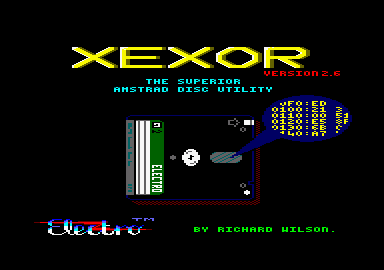Okay, it might sound like a detergent, but this all-in-one disk utility could change the way you program forever. Simon finds out if he'd swap it for his old brand. 
Xexor. So how the hock are we gonna pronounce it ? Zecksor ? Chseckser ?
Probably one of the hardest things I've ever had to write is this review. To be honest, it's hard to know where to start. You see. I've used a tot of disk utilites in my time (I've written a fair few as well, but never before have i seen a once of work that's so comprehensive.
A lot of people will tell you that the one thing you really need in order to keep your disk system running like clockwork is a suite of disk utilities comprising the following essentials: - A formatter
Formatters are essential. What more can I say? (About another su toes'worth - Dave.) When you buy a box of blank disks, whether 3-inch or 3.5-inch, you'll need to prepare them for use on a CPC. This process a known as formatting. CP/M provides Ite function, but in a very long-winded and mcredibly user-unfrienoly way. - A file manager
A Die manager is a package that'll take care ofl all file copying and attriDute needs you may have. The copying side is pretty self-explariatory, but artnbutes are a bit more ot a problem You see, file don't just sit on a disk - they can have many attributes, such as whether or not they're visible to the user when the disk is catalogued, which user area they're placed in and whether or not they can be erased. Attributes such as visibility (invisible files are known as system files) and write protections are incredibly difficult to set and change from withm AMSOOS alone. The only method outside buying a specialist disk package is to load CP/M [the extra disks provided with the machine on Purchase), and use utilities such as PIP. However, with CP/M being the antiquated beast it is and loading times (on disk, remember) taking what seems like another ice age, the Solution is far from perfect.
- A copier
As wen as occasonaHy copying single files, you'll sometimes need to make copies of entire disks. There are many copters around (indeed, CP/M Comes with one), but there aren't that many that deal with strange sector identities and such like And trust me, you'll occasionally need one! - An Editor
Editors aren't so essential (pardon? - Dave). Nor are they all mat useful to your average disk user, but every now and agam you will come across the need for one. A sector editor (an editor) is a program that allows you to go through the disk byte by byte, and look at the information as it's stored on the disk, as opposed to loading in each individual file and examining tt that way, suffering the traumas of such things as protection systems.

Of course , we could always assign yet another phoneme to the letter Z...
The all-in-one solution
But why take lour utility packages into the shower? Xexor does all these functions. It serves every single need listed, and it serves them well. On boot up, you are presented with a command line which you use to tell the package exactly what you want n to do (rather like BASIC). If you can't get along with that kind of input system, though, you can use the menu system. As for user friendliness, each command is fully documented in a structured and intelligent Help system, which provides easy access to full instructions for every single command.
As if that wasn't enough. Xexor also provides another useful feature - ROMs. There is a command in the package that provides a ROM image. This is a 16K tile that can be blown on to an EPROM usmg a blower, and inserted into either a ROM board, or in place ot your machine's intemal AMSDOS ROM. Convention dictates that a good review has to highlight some bad points as we» as all the good ones. Well, I tried hard, but i ready couldn't find any major gripes. The only possible fault is incompatibility with ROMDOS , but Xexor provides its equivalent in the form of a ROM anyway (which, I get the feeling, STS may be producing separately pretty soon, for all those who don't have access to a ROM-blowing system). The only shame is that this package didn't appear two months ago. as it would have quite easily scooped the Sugar awards for Disk Utilities and DOS Systems. Belated congratulations. STS
| ★ AMSTRAD CPC ★ DOWNLOAD ★ |
|
CPCrulez[Content Management System] v8.732-desktop/c
Page créée en 000 millisecondes et consultée 4359 foisL'Amstrad CPC est une machine 8 bits à base d'un Z80 à 4MHz. Le premier de la gamme fut le CPC 464 en 1984, équipé d'un lecteur de cassettes intégré il se plaçait en concurrent du Commodore C64 beaucoup plus compliqué à utiliser et plus cher. Ce fut un réel succès et sorti cette même années le CPC 664 équipé d'un lecteur de disquettes trois pouces intégré. Sa vie fut de courte durée puisqu'en 1985 il fut remplacé par le CPC 6128 qui était plus compact, plus soigné et surtout qui avait 128Ko de RAM au lieu de 64Ko. |
|
|
